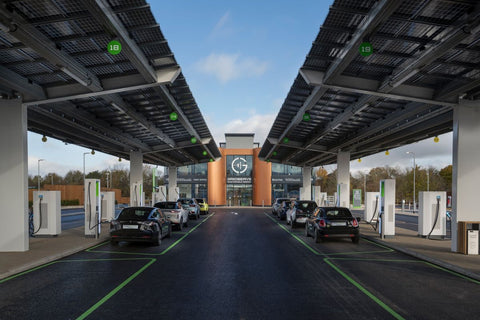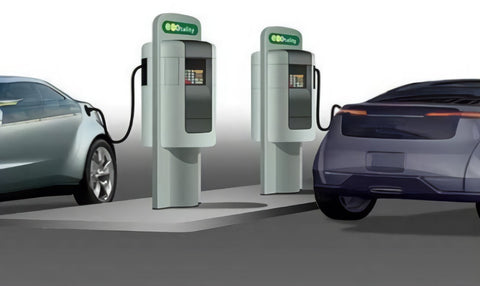Are All Electric Car Charging Stations the Same? Unveiling the Diversity in Charging Infrastructures
In the era of accelerating environmental consciousness and technological innovation, electric vehicles (EVs) have emerged as the vanguards of sustainable transportation. As the world transitions towards a greener future, the spotlight is increasingly turning to the backbone of electric mobility—the charging stations. The question that looms large is whether all electric car charging stations are cut from the same cloth. Beneath the seemingly uniform facade lies a diverse landscape of charging infrastructures, each with its own nuances and quirks.

The Rise of Electric Mobility
Before delving into the intricacies of charging stations, let's take a moment to appreciate the phenomenal rise of electric mobility. With concerns about climate change and air pollution escalating, governments, businesses, and consumers are embracing electric vehicles as a cleaner and more sustainable alternative to traditional internal combustion engine vehicles.
The transition to electric vehicles is not just a trend; it's a seismic shift that is reshaping the automotive industry. Automakers are investing heavily in electric vehicle development, and governments worldwide are rolling out initiatives to encourage EV adoption. However, the success of this transition is contingent on the availability and efficiency of charging infrastructure.
The Tapestry of Electric Car Charging Stations
On the surface, all charging stations might seem alike—a place where electric vehicles connect to a power source to recharge their batteries. However, beneath this superficial similarity lies a rich tapestry of diversity. Let's unravel the layers and explore the fascinating world of electric car charging stations.

1. Charging Speeds: The Need for Speed
Not all electric car charging stations provide the same charging speed. Charging stations are categorized into different levels based on their power output.
-
Level 1 (AC Charging): These are standard household outlets (120 volts) that provide a slow charging rate. While suitable for overnight charging at home, Level 1 charging is not practical for a quick top-up during a road trip.
-
Level 2 (AC Charging): Found in public charging stations and some home installations, Level 2 chargers operate at 240 volts. They deliver a faster charging speed compared to Level 1, making them suitable for workplace and public charging.
-
DC Fast Charging (Level 3): This is where the game changes. DC fast chargers operate at a higher voltage and power level, providing a significantly faster charging experience. They are typically found along highways and in locations where quick charging is crucial.
The diversity in charging speeds caters to the varied needs of electric vehicle users. While Level 1 chargers are ideal for overnight charging at home, Level 2 and DC fast chargers are essential for those seeking quick top-ups on the go.
2. Connector Types: The Puzzle Pieces
Another layer of diversity lies in the types of connectors used by charging stations. The two main connector types are:
-
CHAdeMO: Developed in Japan, CHAdeMO is a fast-charging connector used predominantly by Asian automakers. It is commonly found in DC fast charging stations.
-
CCS (Combined Charging System): Backed by a coalition of international automakers, CCS has become a standard in Europe and North America. It combines AC and DC charging in a single connector, offering flexibility to users.
-
Tesla Supercharger: Exclusive to Tesla vehicles, the Supercharger network is a proprietary fast-charging system designed for Tesla cars.
This diversity in connector types poses a challenge for the standardization of charging infrastructure. While efforts are being made to establish universal standards, the presence of different connectors adds complexity for both charging station operators and electric vehicle manufacturers.
3. Networks and Accessibility: The Web of Connectivity
Beyond charging speeds and connector types, the accessibility and availability of charging stations contribute to the diversity of the charging landscape.
-
Public Charging Networks: Numerous public charging networks, such as ChargePoint, EVgo, and Electrify America, have established a widespread presence, offering charging stations in various locations. These networks often require users to sign up for memberships or use proprietary apps for seamless access.
-
Proprietary Charging Networks: Some automakers, like Tesla, have developed their own proprietary charging networks. While convenient for Tesla owners, this exclusivity can be a barrier for users with vehicles from other manufacturers.
-
Interoperability Challenges: The lack of standardized protocols and interoperability between different charging networks can pose challenges for EV users. Efforts are underway to address these issues and create a more cohesive charging infrastructure.
The Future of Charging Stations
As electric vehicles become more prevalent, the landscape of charging stations is evolving rapidly. Several trends and innovations are shaping the future of electric car charging:

1. High-Power Charging: The Need for Speed Continues
The race for faster charging speeds is ongoing. High-power charging stations, with capacities exceeding 350 kW, are being developed to significantly reduce charging times. These stations have the potential to recharge electric vehicle batteries to 80% or more in just a few minutes.
2. Renewable Energy Integration: Powering the Future Sustainably
Many charging stations are incorporating renewable energy sources, such as solar and wind, to reduce their environmental impact. The integration of clean energy aligns with the overall goal of creating a more sustainable and eco-friendly transportation ecosystem.
3. Smart Charging Infrastructure: Navigating the Grid
The concept of smart charging involves the use of advanced technologies to optimize the charging process. This includes features like dynamic pricing based on electricity demand, real-time data analytics, and integration with smart grids. Smart charging infrastructure aims to enhance user experience, grid efficiency, and overall system reliability.
4. Battery Swap Stations: Redefining Convenience
Battery swap stations represent an innovative approach to charging. Instead of waiting for a battery to charge, users can opt to exchange their depleted battery for a fully charged one. This approach could revolutionize the charging experience, especially for commercial and fleet vehicles.
Conclusion: Navigating the Charging Landscape
In conclusion, the notion that all electric car charging stations are the same is a myth. The diversity in charging speeds, connector types, networks, and innovations creates a rich and complex landscape. As the electric vehicle revolution gains momentum, the evolution of charging infrastructure will play a pivotal role in shaping the future of transportation.
While challenges such as standardization and interoperability persist, ongoing efforts by industry stakeholders and technological advancements are gradually unraveling the complexities of the charging landscape. As electric mobility becomes more accessible and widespread, the diversity in charging stations will continue to be a defining characteristic of the electric vehicle experience.
So, the next time you plug in your electric vehicle, take a moment to appreciate the intricate web of charging stations that powers the wheels of sustainable transportation—a web where diversity is the key to driving us into a cleaner, greener future.







